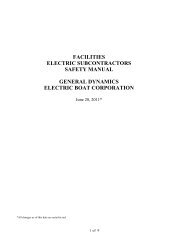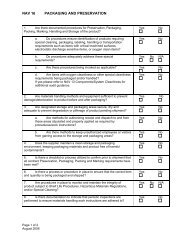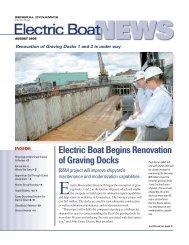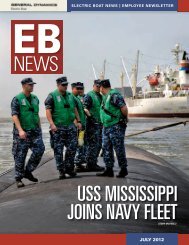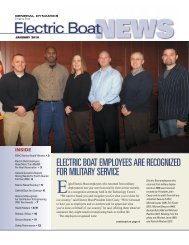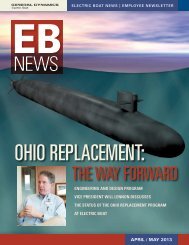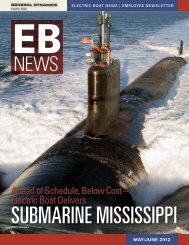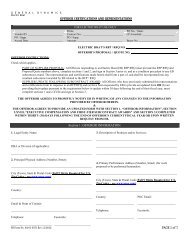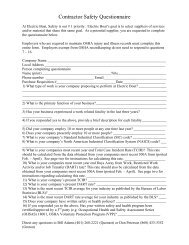electric boat news | september 2011 - Electric Boat Corporation
electric boat news | september 2011 - Electric Boat Corporation
electric boat news | september 2011 - Electric Boat Corporation
Create successful ePaper yourself
Turn your PDF publications into a flip-book with our unique Google optimized e-Paper software.
SEPTEMBER <strong>2011</strong><br />
INSIDE<br />
Earned Hours Incentive Program<br />
Heads into the Fourth Quarter • 2<br />
New Hires • 3<br />
Kesselring Site Office<br />
Successfully Completes MARF<br />
Prototype Extended Shutdown • 4<br />
Mississippi Sailor Selected<br />
as “Service Person of the Month” • 5<br />
Health Matters • 6<br />
Breast Cancer and Early Detection:<br />
A First Person Account<br />
from Kristin Fletcher • 7<br />
Marine News Roundup • 9<br />
Service Awards • 10<br />
Ethics • 11<br />
Retirees • 11<br />
Safety Performance • 12<br />
WITH CONSTRUCTION START ON SSN-787,<br />
SUBMARINE PRODUCTION RATE<br />
INCREASES TO TWO PER YEAR<br />
With the start of construction on the unnamed SSN-<br />
787 earlier this month, the Navy’s submarine program<br />
marked a significant and long-awaited milestone<br />
– the production of two Virginia-class ships per year.<br />
“The last time two submarines of the same class started construction<br />
in the same year was 22 years ago,” said John Holmander,<br />
VP – Virginia Program.<br />
This milestone is very important to the submarine program<br />
and <strong>Electric</strong> <strong>Boat</strong>,” he said. “It will bring a level of stability to the<br />
Groton waterfront that we haven’t seen in many years.”<br />
<strong>Electric</strong> <strong>Boat</strong> and its construction partner, Huntington Ingalls,<br />
continued on page 3<br />
The Virginia-class<br />
submarine California (SSN-<br />
781) gets under way from<br />
Naval Station Norfolk to<br />
conduct weapons systems<br />
acceptance trials earlier<br />
this month. California is<br />
the eighth Virginia-class<br />
submarine and is scheduled<br />
to be commissioned Oct. 29.<br />
(U.S. Navy photo)
EARNED HOURS<br />
INCENTIVE<br />
PROGRAM<br />
HEADS INTO THE<br />
FOURTH QUARTER<br />
As <strong>Electric</strong> <strong>Boat</strong> begins the final quarter of <strong>2011</strong>, the company<br />
is running behind its Earned Hours Incentive Program goal<br />
by 205,000 hours.<br />
Now in its 11th year, the program has a baseline goal for <strong>2011</strong> of 18.7<br />
million earned hours. If this goal is achieved, eligible employees will<br />
receive $500, minus withholdings.<br />
If the stretch goal of 19.6 million hours is achieved, each employee<br />
will receive another $250, for a total potential incentive reward of<br />
$750.<br />
The earned hours measurement is a tool the company employs to<br />
track its cost and schedule performance. By using this tool, the company<br />
can determine its progress toward the annual goal on a month-tomonth<br />
basis.<br />
“The Earned Hours Incentive Program is important to the company,<br />
but it also benefits employees by providing them with the opportunity<br />
to share in <strong>Electric</strong> <strong>Boat</strong>’s financial success,” said Kevin Carroll,<br />
director of Program Finance, Contracts and Estimating. “Everyone<br />
has the chance to come out ahead.”<br />
To be eligible for the incentive, employees must:<br />
P Work 1,000 hours during <strong>2011</strong> (excluding absences of any kind).<br />
P Be on the payroll as of Dec. 1, <strong>2011</strong>, with the following exceptions:<br />
n Employees who retiree in <strong>2011</strong> must work at least eight<br />
hours in <strong>2011</strong>.<br />
n Employees who are laid off in <strong>2011</strong> must work at least<br />
1,000 hours in <strong>2011</strong>.<br />
“To reach this year’s earned hours goal, we need to support the Ohio-<br />
Replacement Program and the ramp-up of the Moored Training Ship<br />
program within the engineering business area, and continue our support<br />
of the Navy shipyards and the drive to deliver the Mississippi<br />
(SSN-782) early next year,” said Carroll.<br />
2 | ELECTRIC BOAT NEWS | SEPTEMBER <strong>2011</strong>
WELCOME TO ELECTRIC BOAT<br />
PLEASE HELP WELCOME THE FOLLOWING EMPLOYEES,<br />
WHO HAVE RECENTLY JOINED THE COMPANY<br />
272 Wayne Carpenter<br />
433 Gregory Hew<br />
644 Samara Russell<br />
Dan Barrett, Editor<br />
330 Kenneth Ferguson<br />
341 Julie Dupont-Woody<br />
404 James Ivey<br />
410 Marcos Quintana<br />
411 Jonathan Nikodem<br />
438 Perrilea Phoenix<br />
445 Michael Audette<br />
449 Andrew Donihe<br />
James Stumme<br />
Tin Truong<br />
463 David Skidmore<br />
663 David Borkenhagen<br />
670 Clea Duffy<br />
Anthony McDonald<br />
Joseph Sakmar<br />
702 Jason Lamp<br />
Bob Gallo, Gary Slater,<br />
Gary Hall, Photography<br />
<strong>Electric</strong> <strong>Boat</strong> News<br />
is published monthly by the<br />
Public Affairs Department,<br />
75 Eastern Point Road,<br />
Groton, CT 06340<br />
413 Matthew Noll<br />
472 Tammie Patterson<br />
Phone (860) 433-8202<br />
415 Amanda Chen<br />
502 Kayti Poplaski<br />
Fax (860) 433-8054<br />
416 Robert Brouillier<br />
419 David Steere<br />
429 Nathan Clark<br />
431 Dylan Alexander<br />
505 Richard Chapman<br />
Frank DeCaro<br />
545 Diane M. Levreault<br />
626 Christine Burns<br />
Email dbarrett@gdeb.com<br />
2 SUBS PER YEAR<br />
continued from page 1<br />
have been preparing for the production increase for several<br />
years, Holmander said. These preparations have included a $124<br />
million capital investment allocated to production-improvement<br />
projects at the Quonset Point modular construction facility and<br />
the Groton shipyard, where final assembly and test is performed,<br />
he said.<br />
“We’re going to continue our efforts to improve construction<br />
efficiencies so that Virginia-class submarines are more affordable<br />
for our customer,” said Holmander, noting that affordability<br />
is the linchpin to continuing the two-per-year production rate.<br />
“To get to this important point, our Navy/industry shipbuilding<br />
team executed a very successful design for affordability program<br />
that yielded significant cost savings and has allowed the<br />
Navy to increase production in a fiscally-responsible manner,”<br />
said Rear Adm. David Johnson, program executive officer for<br />
submarines.<br />
“A great deal of our success comes from increasing construction<br />
efficiencies; our last two submarines were delivered in 65<br />
months, which is eight months early to their contract delivery<br />
date and we are well on our way to getting that number down to<br />
60 months for our two fiscal year 2012 authorized <strong>boat</strong>s (SSN-<br />
788 and SSN-789),” Johnson said.<br />
According to Holmander, the next ship and the ninth of the<br />
class, Mississippi (SSN-782), is tracking to be delivered 12<br />
months ahead of schedule and more than $50 million under contract<br />
target budget.<br />
The design for affordability program involved redesigning<br />
portions of the Virginia Class to reduce costs and construction<br />
time. The program has yielded significant cost savings for the<br />
Virginia Class, reducing its per-submarine acquisition costs by<br />
nearly 20 percent while shortening their construction span from<br />
84 months to 60. These efforts significantly contributed to the<br />
increased production rate.<br />
“Our team has been diligently driving down the cost and construction<br />
time of these submarines to get to this key two per year<br />
milestone,” said Rear Adm. (sel.) Michael Jabaley, the Navy’s<br />
Virginia-class program manager. “Building two submarines per<br />
year is the most economical way to procure these <strong>boat</strong>s and will<br />
help ensure that our submarine force has the platforms it needs<br />
to carry out its various missions.”<br />
Connecticut Congressman Joe Courtney, D-2nd District,<br />
praised <strong>Electric</strong> <strong>Boat</strong> as construction began on SSN-787. “This<br />
milestone is the culmination of years of hard work by many people,<br />
especially the men and women of <strong>Electric</strong> <strong>Boat</strong>,” he said.<br />
Two more Virginia-class program events will be held later this<br />
year – the California (SSN-781) will be commissioned in Nor-<br />
folk, Va., on Oct. 29, and Mississippi (SSN-782) will be christened<br />
at the Groton shipyard on Dec. 3.<br />
ELECTRIC BOAT NEWS | SEPTEMBER <strong>2011</strong> | 3
KESSELRING SITE OFFICE SUCCESSFULLY COMPLETES<br />
MARF PROTOTYPE EXTENDED SHUTDOWN<br />
E<br />
lectric <strong>Boat</strong>’s Kesselring Site Office (KSO) recently completed its<br />
assignment as the Lead Maintenance Activity for the MARF Prototype<br />
<strong>2011</strong> Extended Shutdown (XSD). MARF is an acronym for Modifications<br />
and Additions to Reactor Facilities.<br />
All work was completed on schedule and under budget, allowing the<br />
MARF plant to be returned to its purpose as a training platform for the U.S.<br />
Navy. The successful completion of this major project was the result of a<br />
combined effort by <strong>Electric</strong> <strong>Boat</strong>, Knolls Atomic Power Laboratory (KAPL),<br />
continued<br />
All work was completed on schedule and under budget, allowing the MARF<br />
plant to be returned to its purpose as a training platform for the U.S. Navy.<br />
From left, Lt. Cmdr. Jesse<br />
Stoffel, MARF executive<br />
officer; Rich Reichard,<br />
plant manager, KAPL<br />
(MARF) Nuclear Prototype<br />
Training Unit in Ballston<br />
Spa, N.Y.; Adm. Kirkland H.<br />
Donald, director of Naval<br />
Nuclear Propulsion; and<br />
Mike Crimmins, <strong>Electric</strong><br />
<strong>Boat</strong>’s MARF Extended<br />
Shutdown project<br />
manager.<br />
4 | ELECTRIC BOAT NEWS | SEPTEMBER <strong>2011</strong>
MISSISSIPPI SAILOR<br />
SELECTED AS “SERVICE<br />
PERSON OF THE MONTH”<br />
A letter of thanks and appreciation from Director of Naval<br />
Reactors K.H. Donald, Admiral, U.S. Navy, sent to the members<br />
of the MARF XSD Team.<br />
and Naval personnel led by <strong>Electric</strong> <strong>Boat</strong> MARF XSD<br />
Project Manager Mike Crimmins and KAPL MARF<br />
Plant Manager Rich Reichard.<br />
Adm. Kirkland Donald, director of Naval Nuclear Propulsion,<br />
later toured the MARF Plant and recognized<br />
Crimmins, Reichard and the MARF XSD Team with an<br />
Admiral’s “Four Star Letter” for a job well done.<br />
The <strong>Electric</strong> <strong>Boat</strong>/KSO effort received significant support<br />
from personnel throughout company, many of whom<br />
travelled to the Kesselring Site to assist in the deck-plate<br />
execution of the work or perform independent technical or<br />
program reviews before and during the XSD.<br />
Asailor assigned to the submarine Mississippi<br />
(SSN-782) has been named “Service Person<br />
of the Month” for September by the Southeastern<br />
Connecticut Chamber of Commerce and other<br />
organizations for his support and efforts in the local<br />
community.<br />
The award recipient, Machinist’s Mate 1st Class<br />
(SS/SW) James Pearson, serves as the volunteer coor-<br />
dinator for Mississippi. He was honored for his work<br />
at a luncheon at the Groton Inn & Suites.<br />
“My overall plan for Mississippi all along has been<br />
to inform the local community about the U.S. Navy,<br />
and in particular, PCU Mississippi,” said Pearson.<br />
“I think more sailors should volunteer in their local<br />
communities to really gain an appreciation for the<br />
community.”<br />
The Ledyard Rotary Club presented the Service<br />
Person of the Month award to Pearson. This program<br />
provides community recognition of outstanding<br />
active-duty enlisted personnel stationed in the Groton-New<br />
London area. The program is coordinated<br />
by the Southeastern Connecticut Chamber of Commerce<br />
in cooperation with local active-duty military<br />
organizations.<br />
Since mid-2010, sailors aboard Mississippi have<br />
assisted with projects from cooking for veterans in<br />
the local area; educating students about the military<br />
at John B. Stanton Elementary School; conducting<br />
repairs at the New London Homeless Hospitality Center<br />
to packing boxes for deployed Connecticut service<br />
members.<br />
“Since becoming the community service coordinator<br />
in July 2010, he has recruited 55 crew members of<br />
PCU Mississippi to participate in the community ser-<br />
vice program,” said Cmdr. John McGrath, commanding<br />
officer of PCU Mississippi. “These dedicated volunteers<br />
have donated over 90 hours of cumulative<br />
community service per month.”<br />
Pearson said their volunteer program was created<br />
to emphasize their interest in Connecticut, and their<br />
desire to offer assistance wherever necessary. The<br />
program has impacted more than 10,000 people.<br />
“PCU Mississippi is extremely proud of Petty Officer<br />
Pearson and because of his hard work, dedication,<br />
and volunteer spirit. As a result of his efforts,<br />
the command enjoys a strong and vibrant relationship<br />
with the citizens, government, and civic organizations<br />
of New London County,” said McGrath.<br />
ELECTRIC BOAT NEWS | SEPTEMBER <strong>2011</strong> | 5
HEALTH<br />
MATTERS<br />
Bob Hurley, M.D.<br />
Medical Director<br />
BREAST<br />
CANCER<br />
Over the course of their lives,<br />
women face a one-in-eight<br />
chance that they will receive<br />
a diagnosis of breast cancer.<br />
Ductal and Lobular are the two main<br />
types. Ductal carcinoma starts in the<br />
tubes (ducts) that move milk from the<br />
breast to the nipple. Most breast cancers<br />
are of this type. Lobular carcinoma<br />
starts in the parts of the breast, called lobules,<br />
that produce milk. In rare cases,<br />
breast cancer can start in other areas of<br />
the breast. Breast cancer may be invasive<br />
or noninvasive. Invasive means the cancer<br />
spreads from the milk duct or lobule<br />
to other tissues in the breast. Noninvasive<br />
means it has not yet invaded other breast<br />
tissue and is called “in situ.” Thus, ductal<br />
carcinoma in situ (DCIS), or intraductal<br />
carcinoma, is breast cancer in the lining<br />
of the milk ducts that has not yet invaded<br />
nearby tissues. If left untreated, it may<br />
progress to invasive cancer. Lobular car-<br />
cinoma in situ (LCIS) has a tendency to<br />
progress to invasive cancer in the same or<br />
both breasts.<br />
Some cancers have estrogen receptors on<br />
the surface of their cells. They are called<br />
estrogen receptor-positive cancer or ERpositive<br />
cancer. In the presence of estrogen<br />
these HER2-positive breast cancers<br />
are encouraged to grow. When cells<br />
(including cancer cells) have too many<br />
copies of this gene, they grow faster.<br />
Experts think that women with HER2-<br />
positive breast cancer have a more aggressive<br />
disease and a higher risk that the disease<br />
will return than women who do not<br />
have this type.<br />
Another genetic marker, BRCA1 and<br />
BRCA2, are genes that direct the production<br />
of proteins that protect you from<br />
cancer. If a parent passes you a defective<br />
gene, you have an increased risk for breast<br />
cancer. Women with one of these defects<br />
have up to an 80 percent chance of getting<br />
breast cancer sometime during their life.<br />
Prevention<br />
So what can one do to reduce the chance<br />
of contracting breast cancer There are<br />
some general recommendations but since<br />
the exact triggering mechanism of this<br />
disease is uncertain there are no specific<br />
actions shown to be preventative. There<br />
are also traits that can’t be changed such<br />
as age and gender. Although breast cancer<br />
is not exclusive to women, female gender<br />
and age are two significant risk factors.<br />
A family history of breast cancer may<br />
raise your risk by 20 to 30 percent. Your<br />
genetic makeup and age of first menstruation<br />
as well as menopause all influence<br />
your risk profile.<br />
As for what you can control, we do know<br />
that breast implants, using antiperspirants,<br />
wearing underwire bras or other mechanical<br />
trauma do not raise one’s risk. There<br />
also is inconclusive evidence that pesticides<br />
have a direct causal link to the disease.<br />
Whether one chooses to have children<br />
or not is associated with risk. Women<br />
who have never had children or who had<br />
them only after age 30 have an increased<br />
risk for breast cancer.<br />
Being pregnant more than once or becoming<br />
pregnant at an early age reduces your<br />
risk of breast cancer. Having taken DES<br />
(diethylstilbestrol) to prevent a miscar-<br />
riage has been linked to increased risk as<br />
has hormone replacement therapy with<br />
estrogen for several years or more. If you<br />
received radiation therapy as a child or<br />
young adult to treat cancer of the chest<br />
area, you have a much higher risk for<br />
developing breast cancer.<br />
One controllable behavior is diet. For<br />
example, some data suggests obesity is<br />
linked to breast cancer as this produces<br />
extra estrogen. That having been said,<br />
so far the best advice is to eat a well-balanced<br />
diet and avoid focusing on one<br />
“cancer-fighting” food<br />
The American Cancer Society’s dietary<br />
guidelines for cancer prevention recommend<br />
that people:<br />
P Choose foods and portion sizes that<br />
promote a healthy weight.<br />
P Choose whole grains instead of refined<br />
grain products.<br />
6 | ELECTRIC BOAT NEWS | September <strong>2011</strong>
P Eat five or more servings of fruits and<br />
vegetables each day.<br />
P Limit processed and red meat in the<br />
diet.<br />
P Limit alcohol consumption to one to<br />
two drinks per day (women with high<br />
risk should consider not drinking at<br />
all).<br />
Symptoms<br />
It would be helpful if early breast cancer<br />
had symptoms, but it usually doesn’t.<br />
That’s why prevention, screening and<br />
early detection programs are so important.<br />
Regular breast exams are important. As<br />
the cancer grows, symptoms may include<br />
findings that you might be able to discern<br />
such as:<br />
P Breast lump or lump in the armpit that<br />
is hard, has uneven edges, and usually<br />
does not hurt<br />
P Change in the size, shape, or feel of<br />
the breast or nipple, for example, you<br />
may have redness, dimpling, or puckering<br />
that looks like the skin of an<br />
orange<br />
P Fluid coming from the nipple; it may<br />
be bloody, clear to yellow, green, and<br />
look like pus<br />
Men can get breast cancer, too. Symptoms<br />
include breast lump and breast pain and<br />
tenderness. Advanced breast cancer may<br />
include:<br />
P Bone pain<br />
P Breast pain or discomfort<br />
P Skin ulcers<br />
P Swelling of one arm (next to the breast<br />
with cancer)<br />
P Weight loss<br />
Breast Screening Recommendations<br />
There are no consensus recommendations<br />
and with updates and revisions, the lay<br />
public often questions what the best way to<br />
screen for breast cancer is. My recommendation<br />
is to review the recommendations<br />
BREAST CANCER AND EARLY DETECTION:<br />
A FIRST PERSON ACCOUNT<br />
FROM KRISTIN FLETCHER<br />
Editor’s note: Earlier this year, Vice<br />
President and Chief Information Officer<br />
Kristin Fletcher was diagnosed with breast<br />
cancer. She wrote the following article to<br />
help raise awareness of the disease and to<br />
stress the importance of early detection.<br />
I am a sleepy head. I hate getting up.<br />
I love to sleep … not a morning person.<br />
Thursday, March 31st, I had pressed the<br />
“snooze” button for the umpteenth time.<br />
My husband was long gone to work. I rolled<br />
over, knowing my time was up if I was<br />
going to make it to my first meeting, and felt something funny in<br />
my right breast. Small. Hard. First thought – it’s probably nothing. I<br />
rolled back over. Thirty seconds later, I was trying to find it again. I<br />
stood up and found it again.<br />
I called my husband, and then the doctor’s office. I knew the doctor’s<br />
office wouldn’t be open for several hours, but I was afraid that<br />
if I waited until later in the day, I wouldn’t do it. This thing was<br />
tiny – pea sized – and I was certain I was being a hypochondriac.<br />
The rest is history. Several weeks later, I was diagnosed with<br />
breast cancer. It didn’t make sense – I was up to date on my mammograms;<br />
another mammogram was performed the week after<br />
I found my lump, and my tumor is not visible on that shot, even<br />
though it was being targeted. I had two independent breast exams<br />
by highly qualified physicians during the three months prior to<br />
finding this lump myself … but no doctor knows my body as well<br />
as I do.<br />
As a result of early detection – I am incredibly fortunate. My<br />
medical team has options for treatment. My treatment is multifaceted.<br />
I have great care. Just a few months after feeling something<br />
unusual in my breast, my treatment is well along and the most dif-<br />
ficult aspects are expected to be completed in a relatively short<br />
period of time. I am certainly not in a position to declare victory,<br />
but I do have reason to be very optimistic regarding my prognosis.<br />
I have told my son that I will be around to haunt him for 40 more<br />
years.<br />
As far as I’m concerned, it doesn’t matter whether you do it<br />
clockwise or counterclockwise, on the first day of the month, the<br />
last, or on the full moon. What does matter is that you know your<br />
body, and when something doesn’t feel right, you follow up on it...<br />
as quickly as possible.<br />
Thanks for reading,<br />
Kristin<br />
continued on page 8<br />
ELECTRIC BOAT NEWS | SEPTEMBER <strong>2011</strong> | 7
It would be helpful<br />
if early breast<br />
cancer had<br />
symptoms, but it<br />
usually doesn’t.<br />
That’s why<br />
prevention,<br />
screening and<br />
early detection<br />
programs are<br />
so important.<br />
HEALTH MATTERS / BREAST CANCER<br />
continued from page6<br />
below, speak with a trusted medical provider,<br />
and then decide which course is right for you.<br />
The American College of Obstetricians and<br />
Gynecologists currently continues to recommend<br />
the following services:<br />
P Screening mammography every one to<br />
two years for women from ages 40 to 49<br />
P Screening mammography every year for<br />
women age 50 or older<br />
P Breast Self Examination (BSE) has the<br />
potential to detect palpable breast cancer and<br />
can be recommended<br />
The American Cancer Society recommends:<br />
P Annual mammography beginning<br />
at age 40<br />
P Annual Clinical Breast exam (CBE)<br />
after the age of 40<br />
P Breast MRI is not recommended for<br />
women at average risk for breast<br />
cancer<br />
P There is insufficient evidence to<br />
recommend breast self examination<br />
( BSE)<br />
The American Medical Association (2002)<br />
and the National Comprehensive Cancer Network<br />
(2009) recommend actions similar to<br />
those of the American Cancer Society, with<br />
an exception – they recommend breast self<br />
examination..<br />
The American Academy of Family Physicians<br />
has endorsed the U.S. Preventative Ser-<br />
vices Task Force (USPSTF) recommendations<br />
on breast cancer screening in the past.<br />
The American College of Physicians recommended<br />
in 2007 that screening mammography<br />
decisions in women from ages 40 to<br />
49 should be based on individualized assessment<br />
of risk for breast cancer; that clinicians<br />
should inform women from ages 40 to<br />
49 about the potential benefits and harms of<br />
screening mammography; and that clinicians<br />
should base screening mammography decisions<br />
on benefits and harms of screening, as<br />
well as on a woman’s preferences and breast<br />
cancer risk profile.<br />
The USPSTF recommends against routine<br />
screening mammography in women from<br />
ages 40 to 49 years. The decision to start<br />
regular, biennial screening mammography<br />
before the age of 50 should be an individual<br />
one and take patient context into account,<br />
including the patient’s values regarding specific<br />
benefits and harms.<br />
P The USPSTF recommends biennial<br />
screening mammography for women<br />
from ages 50 to 74 years.<br />
P The USPSTF recommends against<br />
teaching breast self-examination<br />
(BSE).<br />
Calling Your Health Care Provider<br />
Regardless of which guidelines you and your<br />
provider choose to follow, there are some<br />
absolutes. You should contact your health<br />
care provider for an appointment if:<br />
P You have a breast or armpit lump<br />
P You have nipple discharge<br />
Also call your health care provider if you<br />
develop symptoms after being treated for<br />
breast cancer, such as:<br />
P Nipple discharge<br />
P Rash on the breast<br />
P New lumps in the breast<br />
P Swelling in the area<br />
P Pain, especially chest pain,<br />
abdominal pain, or bone pain<br />
For more information, there are multiple<br />
on-line sites such as the National Cancer<br />
Institute, which provides an online tool to<br />
help you figure out your risk of breast<br />
cancer. See: www.cancer.gov/bcrisktool, or<br />
go to www.myuhc.com.<br />
8 | ELECTRIC BOAT NEWS | SEPTEMBER <strong>2011</strong>
MARINE SYSTEMS NEWS<br />
<strong>Electric</strong> <strong>Boat</strong> Supports Submarine Repair<br />
Work at Norfolk Naval Shipyard<br />
<strong>Electric</strong> <strong>Boat</strong> has been awarded a $23 million work order by<br />
the U.S. Navy to support submarine repair work at Norfolk Naval<br />
Shipyard (NNSY) in Virginia.<br />
The work order is part of a Basic Ordering Agreement awarded<br />
to <strong>Electric</strong> <strong>Boat</strong> in September 2010 to support U.S. Navy submarine<br />
repair work.<br />
Under this work order, <strong>Electric</strong> <strong>Boat</strong> trades employees will be<br />
assigned to maintenance activities on USS Newport News (SSN-<br />
750) and USS West Virginia (SSBN-736). The work is scheduled<br />
to be completed by September 2012.<br />
<strong>Electric</strong> <strong>Boat</strong> Receives $33 Million<br />
Contract to Procure Virginia-class<br />
Submarine Photonics Masts<br />
<strong>Electric</strong> <strong>Boat</strong> has been awarded a $32.9 million contract modification<br />
by the U.S. Navy to procure three backup photonics masts<br />
for Virginia-class submarines.<br />
In Virginia-class submarines, traditional periscopes have been<br />
supplanted by photonics masts – non-hull-penetrating masts that<br />
do not extend physically into the control room. Information is<br />
digitally recorded by cameras in the mast, transmitted through<br />
fiber optics into the ship and processed with on-board image processors.<br />
Each photonics mast has an HDTV digital color camera,<br />
an infrared camera and a laser rangefinder.<br />
General Dynamics to Acquire Metro Machine<br />
FALLS CHURCH, Va<br />
General Dynamics has entered an agreement to acquire Metro<br />
Machine Corp., a leading East Coast surface-ship repair company<br />
that supports the U.S. Navy fleet in Norfolk, Va. The value of the<br />
cash transaction, which is expected to be accretive to General<br />
Dynamics’ earnings beginning in 2012, has not been disclosed.<br />
The transaction is subject to normal regulatory approvals and is<br />
expected to close in November.<br />
Metro Machine Corp. is a privately held company that employs<br />
approximately 400 workers. It has been conducting U.S. Navy ship<br />
repair and conversions since 1972. Metro Machine Corp. is a prime<br />
contractor in Norfolk for multi-ship, multi-option (MSMO) contracts<br />
for combat and support ships for the U.S. Navy, including frigates<br />
(FFGs), dock landing ships (LSDs) and amphibious transport ships<br />
(LPDs). MSMO contracts provide for maintenance, modernization<br />
and repair to all ships of a class in specific homeport areas.<br />
Metro Machine Corp. will become part of the shipbuilding and<br />
repair operations of General Dynamics NASSCO. NASSCO, the<br />
largest shipbuilding and repair company on the West Coast, is a<br />
prime contractor for MSMO contracts for Navy combat and support<br />
ships, including FFGs, LSDs, LPDs and amphibious assault<br />
(LHA/LHD) ships. The company employs 3,400 people.<br />
“With its Norfolk location, Metro Machine Corp. will extend<br />
the reach of NASSCO’s ship-repair operations to a key East Coast<br />
naval port,” said NASSCO President Fred Harris. “This move<br />
will enhance General Dynamics’ ability to deliver cost-effective<br />
maintenance and repair services to the U.S. Navy, helping the<br />
Navy to maximize the life of in-service ships and better serve the<br />
ship-repair needs of the entire U.S. fleet.”<br />
BIW Awarded $1.8 Billion for Construction<br />
of Two DDG-1000 Destroyers<br />
BATH, Maine – The U. S. Navy has awarded Bath Iron Works<br />
a $1.8 billion contract for the construction of DDG -1001 and<br />
DDG -1002, the next two ships in the Zumwalt-class program.<br />
DDG -1001 is scheduled to be delivered in December 2015 and<br />
DDG- 1002 is scheduled to be delivered in February 2018.<br />
“This contract enables us to maintain a strong base of quality<br />
shipbuilding jobs in Maine and continue our contributions to sus-<br />
taining the U.S. Navy fleet,” said Jeff Geiger, president of Bath<br />
Iron Works. “It provides Bath Iron Works with a healthy back-<br />
log of work and reflects the Navy’s continued commitment to the<br />
DDG-1000 program, as well as their confidence in our ability to<br />
build and deliver all three ships of this class.<br />
“Winning this work is a result of our commitment to opera-<br />
tional excellence and to finding more efficient, affordable ways to<br />
operate in every part of our business. It gives us the opportunity<br />
to continue introducing new and innovative ways to build capable<br />
ships for the Navy,” Geiger said.<br />
“We appreciate all the support the Maine Congressional delega-<br />
tion has provided to this program. Their commitment to national<br />
defense and their advocacy on behalf of the workers of Maine has<br />
been a crucial factor,” he said.<br />
The first ship in the class, DDG-1000, is more than 50 percent<br />
complete and is scheduled to be delivered in 2014. The DDG-<br />
1000 Zumwalt-class destroyer is the U.S. Navy’s next-generation,<br />
guided-missile destroyer, leading the way for a new generation of<br />
advanced multi-mission surface combat ships. The ships will fea-<br />
ture a low radar profile, an integrated power system and a total<br />
ship computing environment infrastructure. Armed with an array<br />
of weapons, the Zumwalt-class destroyers will provide offensive,<br />
distributed and precision fires in support of forces ashore.<br />
“This contract award demonstrates the Navy’s commitment<br />
to balancing cost, capability and industrial base considerations<br />
to improve the affordability of this shipbuilding program,” Sean<br />
Stackley, assistant secretary of the Navy, said in a statement.<br />
“This is a great example of putting in place should-cost targets to<br />
meet validated warfighting requirements.”<br />
Work is already under way at the Bath, Maine, shipyard on<br />
DDG-1001 and DDG- 1002. Congress previously approved fund-<br />
ing for advanced procurement and initial construction of these<br />
ships. Bath Iron Works is the lead designer and builder for the<br />
program which employs approximately 5,400 people.<br />
ELECTRIC BOAT NEWS | SEPTEMBER <strong>2011</strong> | 9
SERVICE AWARDS H H H H H H H H H H H H<br />
55 Years<br />
412 Samuel J. Grills<br />
45 Years<br />
413 James B. Segar<br />
40 Years<br />
243 Ronald Reed<br />
431 Paul J. Kazlauskas<br />
35 Years<br />
100 Dennis S. Triba<br />
229 David B. Pelletier<br />
229 Richard M. Romyns<br />
230 Carmine F. Penza<br />
230 Stephen E. Rolfe<br />
242 Michael D. Adams<br />
242 Thomas Daniewicz<br />
242 Alan C. White<br />
243 Michael D. Finnigan<br />
243 Gerald S. Poirier<br />
244 Brian P. Chesna<br />
252 Timothy P. Lloyd<br />
252 Gerard W. Manville<br />
252 Benjamin R. Mattos<br />
252 Bruce L. Stefanelli<br />
272 Tommie R. Parr<br />
323 Kevin G. Pincins<br />
355 Raymond P. Arpin<br />
355 Joseph Giorgianni<br />
355 Robert H. Gordy Jr.<br />
406 Harold J. Robb<br />
411 Gara B. Eastman<br />
424 David M. West<br />
452 Michael E. Bessette<br />
459 Clyde T. Britt Jr.<br />
496 Frank A. Laudone III<br />
501 Joseph G. Houle Jr.<br />
553 Jeffrey T. Izzo<br />
601 Robert H. Nardone<br />
642 Lester B. Ahern<br />
691 Elizabeth A. Peterson<br />
795 Gary M. Beaudoin<br />
900 Anthony J. Moniz<br />
901 Thomas G. Blanchette Sr.<br />
902 Paul E. Cagnon Jr.<br />
904 Donald T. Wilsey<br />
915 George P. Cain<br />
915 Robert J. Chabot<br />
921 James P. Hague<br />
921 Murray F. McGrady Jr.<br />
921 Lon W. Planz Jr.<br />
950 Stephen J. Defalco<br />
950 William G. Harford Jr.<br />
950 Sally A. Johanson<br />
950 Raymond G. Schultheiss<br />
957 Barry J. Houston<br />
970 Paul A. Cirillo<br />
30 Years<br />
100 Scott D. McNickle<br />
242 Scott G. Dawson<br />
242 William P. Grohocki Jr.<br />
242 Michael A. Malone<br />
456 Daniel J. Panucci<br />
459 Richard H. Sampson<br />
460 Willard F. Reavis<br />
495 Harold C. Branstrom Jr.<br />
601 Kim R. Shaffer<br />
604 Daniel L. Williams<br />
915 David A. Jackson<br />
25 Years<br />
210 Glenn I. Erickson<br />
341 Raymond J. Albert<br />
409 Mary Hallisey<br />
454 Christopher M. Giordano<br />
456 Virginia L. Payne<br />
467 Alan P. Callaghan<br />
901 John S. Camboia<br />
950 Oscar W. Stone<br />
20 Years<br />
403 David Phoenix<br />
452 Robert T. Hill<br />
453 Stephen A. Payne<br />
455 Cynthia L. Mello<br />
467 Richard E. Murphy<br />
915 Franklin O. Lockwood<br />
10 | ELECTRIC BOAT NEWS | SEPTEMBER <strong>2011</strong>
Retirees<br />
201 Randy J. Williams<br />
32 years<br />
Operations Supervisor<br />
230 Donald E. Greene<br />
33 years<br />
Crane Operator 1/C<br />
274 John R. Bosse<br />
27 years<br />
Elec Tech Nuc/Sy 1/C<br />
355 Richard H. Vescovi<br />
25 years<br />
Prod Planner<br />
400 Herbert C. Rattley, Jr.<br />
35 years<br />
Director of Eng - <strong>Electric</strong>al<br />
423 George H. Gilmore Jr.<br />
27 years<br />
Manager of Quality<br />
452 Paul L. Olivier<br />
37 years<br />
Design Tech-Piping<br />
452 Richard A. Strand<br />
46 years<br />
Piping Sr Designer<br />
452 James R. Willie<br />
41 years<br />
Vent Sr. Designer<br />
459 Christine Dupont<br />
33 years<br />
Arrgt Sr Designer<br />
459 Edward S. Freeman<br />
38 years<br />
Struct Sr Designer<br />
545 Thomas E. Smotherman<br />
36 years<br />
Scrap Matl Sorte W/L<br />
604 Paul P. Macko<br />
37 years<br />
IMS Spec Sr<br />
741 Leon N. Lefevre<br />
46 years<br />
Superintendent-Site<br />
915 Edward M. Ellis<br />
38 years<br />
M/T Tech II<br />
924 Thomas S. Capirchio<br />
27 years<br />
M/T Tech II<br />
972 Walter J. Morris<br />
33 years<br />
Prod Supp Tech I<br />
EB BUSINESS<br />
ETHICS<br />
AND CONDUCT<br />
WORKPLACE VIOLENCE<br />
We do not tolerate violent<br />
behavior at any workplace or<br />
company-sponsored gathering,<br />
whether committed by or against<br />
an employee. The following<br />
behaviors are prohibited:<br />
P Making threatening remarks<br />
P Causing physical injury to<br />
someone else<br />
P Intentionally damaging<br />
someone else’s property<br />
P Acting aggressively in a way<br />
that causes someone else to be<br />
intimidated or fear injury<br />
Always use good judgment and<br />
promptly inform your supervisor,<br />
manager, union steward,<br />
Human Resources or Security<br />
representatives if you observe<br />
behavior that could be dangerous<br />
or violent.<br />
<strong>Electric</strong> <strong>Boat</strong> Ethics Director<br />
Frank Capizzano (860-433-1278)<br />
is available to confidentially assist<br />
anyone with questions or issues<br />
that may relate to ethical decision<br />
making. The General Dynamics<br />
Ethics Hotline is available 24/7<br />
and may be reached at 800-<br />
433-8442 or 770-613-6315 for<br />
international callers who wish to<br />
report an ethical violation. Online<br />
access to the Hotline is available<br />
at www.gd.ethicspoint.com.<br />
Remember – When in doubt,<br />
always ask.<br />
ELECTRIC BOAT NEWS | SEPTEMBER <strong>2011</strong> | 11
STANDARD PRESORT<br />
U.S. POSTAGE<br />
PAID<br />
GROTON, CT<br />
PERMIT NO. 392<br />
ELECTRIC BOAT<br />
SAFETY<br />
PERFORMANCE<br />
YEAR TO DATE<br />
SEPTEMBER <strong>2011</strong>



